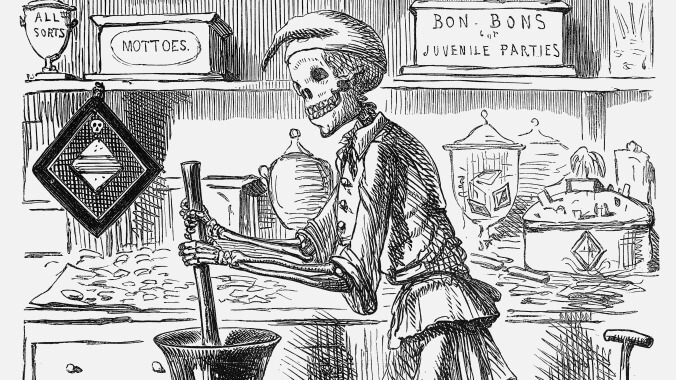Bah! Peppermint “humbugs” poisoned 200 people in 1850s Britain

This week’s entry: 1858 Bradford sweets poisoning
What it’s about: Candy! Laced with arsenic. Which is a very clever way to poison someone in an Agatha Christie novel, but not a great way to run your candy business. That’s exactly how William Hardaker ran his in 1858 England. Wikipedia does not record whether any Oompa Loompas arrived on the scene to celebrate in song any of the 21 deaths that resulted, but we have to assume they did until evidence arises to the contrary.
Biggest controversy: Any political argument about government regulation should keep cases like the Bradford poisonings in mind. In 19th-century Britain the manufacture of candy and most foodstuffs was done with no oversight whatsoever, as was the handling of poisons, which meant there was nothing to stop arsenic from ending up in candies, even ones made by an “experienced sweetmaker.” It took 10 years of this and other, similar incidents for Parliament to pass the Pharmacy Act of 1868, which regulated the sale of dangerous drugs. Among other effects, the opium death rate dropped by 30 percent in the first year alone.
Strangest fact: Arsenic was only a moderate step down from the usual recipe. The poisoned sweets were manufactured by one Joseph Neal, who made “peppermint humbugs” from peppermint oil, sugar, and gum. Sugar was expensive, and Neal saved money by cutting his sugar with powdered gypsum—known in the candy trade as “daff,” “multum,”or “flash,” but known to the layman as plaster. Neal sent a neighbor to a pharmacy owned by Charles Hodgson (it’s not clear why a pharmacist was selling plaster), but Hodgson was out sick. His assistant mistakenly opened a container of arsenic—also an odorless white power that resembles sugar—and that ended up in the peppermints.
Thing we were happiest to learn: Ebenezer Scrooge may have simply been misunderstood. A humbug is a striped peppermint candy traditionally made in the U.K. and many former British colonies, so it’s possible Dickens’ famous miser simply had a sweet tooth and was crying, “Bah, candy!” In fairness, that’s not the most likely explanation. Once the candies became popular, “humbug” also became slang for a joke or a fake. So Scrooge’s yuletide complaint roughly translates to “enough of this nonsense.”
Thing we were unhappiest to learn: Illness was so prevalent in 1850s Britain that it was a long time before anyone even noticed an epidemic of arsenic poisoning. James Appleton, who made the sweets, began to feel ill while making the candy, but shrugged it off as an unrelated illness. “Humbug Billy” Hardaker, who sold the deadly morsels, was among the first to taste them and fell ill as well. When his wares killed two children, locals chalked it up to cholera, which was rampant at the time.
Best link to elsewhere on Wikipedia: The article includes links to a number of poisonings, as well as a link to a list of poisonings. On the list is the Union Carbide disaster in Bhopal, India; the polonium-210 attack on former Russian Federal Security Service agent Alexander Litvinenko; and the mass poisoning our embarrassingly dumb era deserves, the Tide Pod challenge.
Further down the Wormhole: Once Humbug Billy’s customers started becoming sick in significant numbers (21 people died and another 200 were severely ill), several doctors and an “analytical chemist” were called in to verify that arsenic was the cause. It was an important moment in the history of forensic science, which stretches from Agrippina (Emperor Nero’s mother, who identified an enemy’s severed head by her teeth) all the way to CSI: Dubuque (coming this fall to CBS All Access!). In rare instances, forensic science and art intersect, as they did in the Nutshell Studies Of Unexplained Death, which we’ll examine in detail next week.